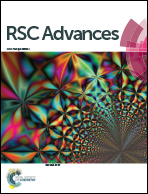Fabrication of porous thin films of block copolymer at the liquid/liquid interface and construction of composite films doped with noble metal nanoparticles†
Abstract
Two approaches have been utilized to fabricate thin composite films of amphiphilic polyisoprene-block-poly(2-vinylpyridine) (PI-b-P2VP) doped with silver and gold nanoparticles. Honeycomb and foam structures were obtained at the interfaces between a chloroform solution of the polymer and aqueous solutions of either AgNO3 or HAuCl4 through the first route. For the second route, porous thin films were obtained at the interfaces between a chloroform solution of the crosslinked polymer by S2Cl2 and pure water, immersed in aqueous solutions of either AgNO3 or HAuCl4 to adsorb metal precursors and then treated with KBH4 aqueous solution to form composite films. The catalytic properties of these films were evaluated by assessing the reduction of 4-nitrophenol by KBH4 in aqueous solutions. It was found that the metal nanoparticles are unstable enough and fused in the film prepared through the first route while the composite film obtained through the second route exhibited good catalytic performance and was more stable during the catalytic reaction. In addition, the porous polymer film is also expected to adsorb other species to form various functional composites.


 Please wait while we load your content...
Please wait while we load your content...